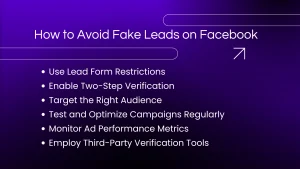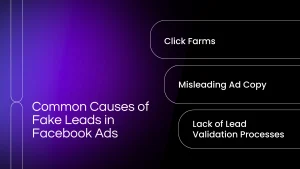How to Spot and Prevent Fake Leads from Facebook Ads
Facebook Ads are a powerful tool for generating leads and driving business growth. However, fake traffic is a significant problem for marketers. Fake leads from Facebook ads may compromise the success of your advertising. False data points waste ad money, inaccurate performance, and lower ROI.
Achieving your company goals depends on good lead quality since real leads are more likely to become devoted consumers. Addressing this issue and protecting your campaigns will maximize your marketing efforts and prevent financial losses.

What Are Fake Leads in Facebook Ads?
In the context of Facebook ads, fake leads are people or entities that interact with your ads without any real goal of buying your goods or services. These users could be curious visitors who click on adverts, automated bots falsifying user behavior, or fake or incomplete submissions.
Although they might fill your lead database, fake leads have little effect on genuine brand interaction or conversions, so altering campaign performance metrics and raising expenses without producing any real value. Detecting and reducing fake interactions is crucial to optimizing ad spend and generating genuine leads.
Common Characteristics of Fake Leads
Maintaining the integrity of your marketing initiatives depends on you spotting fake Facebook leads. If you’re wondering, “Are Facebook leads fake?” — the answer is that some users can be. Often displaying particular behaviors or patterns, these leads can set you apart from legitimate leads.
- Generic or fake names or names with random characters.
- Invalid or disposable email addresses that bounce back or cannot be contacted.
- Phone numbers that are incomplete, invalid, or disconnected.
- Suspiciously quick form submissions with minimal time spent on the ad or landing page.
- Repeated entries from the same IP address or device.
- Lack of engagement with follow-up communication or offers.
Why Fake Leads Are Harmful
Fake leads from Facebook are harmful because they waste time, money, and effort that can be better used for real opportunities. Marketing analytics can be distorted, resulting in wrong insights and poor decision-making. Pursuing fake leads can also deplete sales teams’ output, therefore compromising their capacity to concentrate on real prospects. Dealing with fake users can damage marketing and sales trust, reducing business efficiency and growth.
How to Identify Fake Leads in Your Campaigns
Analyze Email Addresses
Search email submissions for patterns including unusual letter and number combinations or domains not often used. These often indicate fake leads.
Monitor Engagement Patterns
Fake users typically show minimal or no participation in your follow-up campaigns. Track their interactions with your email, website, or other touchpoints to find discrepancies.
Use Lead Verification Tools
Use tools like phone number validation or email verification to confirm the accuracy of submitted information.
Target Specific Audiences in Campaigns
Using Facebook Ads’ thorough demographic and behavioral filters, narrow your target group. A well-defined audience is less likely to result in Facebook fake leads.
Set Up Lead Scoring Criteria
Create scoring systems using behavior, demographics, and other factors to assess lead quality. Low-scoring leads call for more investigation.
Require Double Opt-Ins
By asking a lead to personally confirm their subscription or validate their email address, a double opt-in procedure guarantees their interest and validity.
Watch for Duplicate Submissions
Look for repeated lead submissions that might point to automated bots or suspicious behavior.
Review Ad Placements
Steer clear of less trustworthy placements that can draw non-genuine clicks, such as click farms.
How to Avoid Fake Leads on Facebook
- Use Lead Form Restrictions
- Enable Two-Step Verification
- Target the Right Audience
- Test and Optimize Campaigns Regularly
- Monitor Ad Performance Metrics
- Employ Third-Party Verification Tools
By following these tips, companies may significantly minimize or stop fake leads and boost campaign efficiency.
How to Manage Facebook Fake Leads and Prevent Wasted Ad Spend
Managing fake leads effectively calls for a multifarious approach combining technology, tactics, and continuous analysis. Here are some proven strategies companies can apply to reduce the effect of fake leads and guarantee effective use of their advertising budget:
Use Lead Scoring Systems
Every lead has value determined by its characteristics and behavior under a lead scoring system. This method can identify high-quality leads from fake or disengaged ones. Leaders with a company domain email address, for example, might score better than those who use disposable email services.
Integrate Lead Verification Tools
Third-party lead verification tools can eliminate fake leads from Facebook ads in real time. These instruments check data for anomalies including invalid phone numbers, email addresses, or spammy tendencies to guarantee only real leads pass through your customer funnel. Fraud detection platforms like Clearbit and LeadGenius are well-regarded.
Add Captcha or Verification Steps
Your lead forms can prevent bots and automated scripts from submitting false information with a CAPTCHA or similar verification technique. This extra level of security forces consumers to verify their identity before moving on with the form.
Regularly Review and Cleanse Data
Reviewing your lead data regularly guarantees that you are using correct and trustworthy information. Spot-checking CRM entries reveals fraudulent submission trends. Review past data also to find campaigns or audiences connected to high fake-lead rates and then adjust.
Optimize Ad Targeting
Audience targeting is key to decreasing fake leads from Facebook ads. On ad networks like Facebook or Google AdWords, use powerful targeting tools to concentrate ads on particular groups depending on thorough demographics, interests, and activities. Exclude areas or demographics that create spammy or irrelevant leads.
Leverage Conversions API
Facebook’s Conversions API (CAPI) helps advertisers track and understand customer activities beyond clicks. This tool helps you to match your advertising measurements with your actual website conversions, revealing real intent and helping to prevent possible click fraud.
Set Strict Lead Criteria
Use qualifying questions or stages in lead-generation forms to filter leads. Fields asking for job titles, company data, or purchase intent let you spot and rank qualified prospects and discourage bots or uncommitted candidates from submitting.
Common Reasons Fake Leads Occur in Facebook Ads
Many Facebook advertisers wonder, “Why am I getting fake leads on Facebook?” Fine-tuning your advertising plan and making sure your campaigns produce real, high-quality leads depend on you knowing these reasons. Below, we discuss the most typical causes of Facebook ad fake leads and how to avoid them.
- Click Farms: In click farms, people or groups falsify ad interactions to generate fake leads.
- Improper Audience Targeting: Inaccurate audience targeting can draw users who are not interested in your product or service, thereby producing useless or fake leads.
- Bots and Automation Tools: Bots can falsify lead forms or ad submissions to waste ad budget.
- Lack of Lead Validation Processes: Without proper tools or processes in place to verify lead authenticity, fake leads from Facebook ads can easily slip through unchecked.
- Engagement Bait Strategies: Engagement bait campaigns may get visitors to click on adverts without real interest, generating fake leads.
- Misleading Ad Copy: Misleading or unclear content in ads might draw people who misunderstand the offer, therefore producing leads devoid of real intent.
- Competitor Sabotage: Competitors may provide fake leads to waste advertising money and manipulate campaign metrics.
Understanding these common reasons helps advertisers to protect their campaigns and guarantee more consistent lead generation by acting early on these aspects.
Building Campaigns That Deliver Real Results
Fake leads from Facebook ads can waste advertising money, misrepresent campaign KPIs, and impair business results. Creating ad campaigns that draw real prospects starts with spotting and fixing the sources of fake leads, such as rival intervention or deceptive advertising language. Your Facebook ad budget will engage actual potential consumers, maximize ROI, and drive long-term business success with this proactive approach. Building affordable campaigns with consistent and real results depends on giving your leads top priority in accuracy and quality.
If you’re looking to eliminate fake leads and supercharge your campaigns, contact Webugol today. Our team of digital marketing experts is ready to help fine-tune your strategy for sustainable growth and better return on ad spend.




